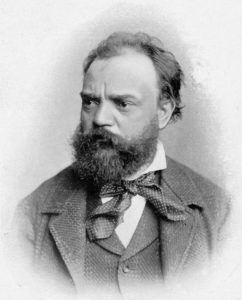
February 5, 2018
Do You Hear the People Sing? Dvořák’s Symphony No. 7
Culture wars, political dysfunction and rising ethnic tensions—these were the problems that plagued Austria-Hungary in the 1880s, and the Czech composer Antonín Dvořák would be caught in the cross-hairs. The immediate problems of the 1880s had deep roots, however; for centuries, Czech lands had been ruled by the Austrian Hapsburg monarchy, and Czech peoples were often relegated to second-class status within the empire.

Within the world of music, Czechs had often found success in the past by Germanizing their names and composing music in a cosmopolitan, international style. After the French revolution, however, this became increasingly impossible as the international style of music disintegrated. Dvořák, the son of a modest line of butchers and innkeepers, was Czech through and through, and alongside his older contemporary Bedřich Smetana, he set out to create a Czech style of classical music.
Dvořák’s Big Break
His first international success came in 1877. Already acclaimed as one of the greatest living composers of the day, Johannes Brahms (a German from Hamburg) sat on a jury that awarded state pensions from the Imperial government to poor but talented Czech composers. Since 1875, Brahms had taken notice of the music that Dvořák had submitted, and that year he decided to pass along one of his lighter pieces (the Moravian Duets) to his publisher, believing they would be popular best-sellers that would bring Dvořák some much-needed income. The publisher agreed, and in addition to publishing the duets, he also commissioned Dvořák’s first set of Slavonic Dances. Their publication quickly brought Dvořák money and international fame.

He was not content to simply be known as a composer of catchy dance music, however; Dvořák had ambitions to write great symphonies in the tradition of Mozart and Beethoven. Sensing a kindred musical spirit in Dvořák, Brahms soon began mentoring the younger composer, giving feedback and constructive criticism on some of his more ambitious pieces. The two would become lifelong friends.
Though Dvořák was no radical, there was also a political dimension to his ambitions, as German-speaking Austrians of the time often pointed to their symphonic music as evidence of their supposed cultural superiority over Czechs. Austrian Germans were happy to accept Dvořák’s lighter, popular music, but winning recognition as a “serious” composer would be more difficult. Dvořák wanted to prove himself in German music’s most prestigious genres, and his Sixth Symphony had been designed to do just that: it was a sunny, pastoral work full of allusions to the symphonies of Beethoven and Brahms that Viennese connoisseurs could not fail to miss.
A Bohemian Glass Ceiling
Unfortunately, none of that seemed to matter. After the election of 1879, the long dominant German-speaking liberals lost to a seemingly unlikely coalition of conservative Germans, Czech nationalists and Polish gentry (please note that the terms liberal and conservative had different meanings then than they do today). The resulting politicization of society increasingly extended to every facet of culture, including music.
Though hardly enlightened by today’s standards, liberal German Austrians had previously seen it as their mission to “civilize” the Slavic peoples within the empire, and believed that anyone could become “German” (read: modern/civilized) so long as they learned to speak German, received an education and adopted German customs. As the nineteenth century drew to a close, however, in the minds of some people ethnicity became increasingly essentialized. It didn’t matter if you walked the walk and talked the talk; your ethnicity was not what you did but who you were, and could never be changed. This attitude would manifest most perniciously in the rise of antisemitism (as Mahler would learn all too well), but also applied to Czechs like Dvořák.

Though the premiere of Dvořák’s Sixth was scheduled to be given by the Vienna Philharmonic during the 1880-81 season, after a number of delays and excuses it was dropped. Though no one would say it, this was likely a reaction to the cool audience response that Dvořák’s Slavonic Rhapsody No. 3 had received just after the election the year before. One critic remarked, “The Slavic folk school is not loved in Vienna…A rhapsody that is written by a Czech and proclaims itself Slavic will encounter a quiet opposition…” Sometimes the opposition was not so quiet; less sympathetic critics introduced a nasty strain of racism into their reviews, implying that Czech music and Czech composers could never equal German ones. While more old-fashioned, liberal critics like Eduard Hanslick would champion Dvořák’s music, others would continue to reject it no matter what it sounded like.
Dvořák’s Sixth Symphony thus premiered in Prague instead. Soon after, it was performed in London where the public, far removed from Austrian politics, enthusiastically recognized it as a masterpiece. After performing a number of his other works, the London Philharmonic commissioned a new symphony from him in 1884.
This was the most prestigious commission of his career thus far; it was the London Philharmonic Society that had commissioned Beethoven’s legendary Ninth Symphony nearly 70 years before, after all. Dvořák determined that his next symphony would be grander, more serious in tone, and more perfect than any he had composed before, a symphony “capable of stirring the world, and may God grant that it will!” His sketches show that he worked and reworked his symphony tirelessly, striving for an artistic breakthrough. He believed that if he succeeded in winning over the audiences of Europe, the entire Czech nation would benefit. If a Czech composer could write a symphony as great as any by a German composer, surely the Austrian Germans would have to acknowledge Czechs as their equals.
A Symphony to Stir the World
On the first page of the manuscript, he cryptically wrote that “This main theme occurred to me upon the arrival at the station of the ceremonial train from Pest in 1884.” The train was carrying Czechs from Hungary to Prague for a performance at the National Theater, which was followed by a pro-Czech political demonstration.
https://www.youtube.com/watch?v=wHnBrYtoICg&t=11s
The theme emerges in the cellos and violas above a low rumbling from the basses, timpani and horns. It progresses haltingly, as if looking over its shoulder. After a brief, pastoral horn solo, the theme returns dramatically in the full orchestra. The following transition leads to a more lyrical theme for flute and clarinets, which becomes more passionate when transferred to the violins. The theme dies away, only to be reinvigorated by fragments of the opening theme, which return defiantly in major. After an exhilarating passage based on the lyrical second theme, the music becomes quieter, leading to a tumultuous development in which the themes are fragmented and transformed. At the climax of the movement, the opening theme returns in a powerful, condensed form that segues to the lyrical second theme. The violent coda that follows dies away as the movement concludes with a final appearance of the opening theme.
The slow second movement begins with an introduction, a peaceful, hymn-like chorale for woodwinds and pizzicato strings. When the strings begin to bow their instruments, the flutes and oboes begin the main melody, a long, lyrical theme. It is soon interrupted, however, by a questioning soliloquy for violins and cellos that is met with an ominous, stern response. A lyrical melody for horn with shimmering accompaniment appears, growing in a crescendo that unexpectedly takes a dramatic turn. After intense, searching developments, the main theme reappears in the cellos. This time, the violin’s soliloquy leads to an emotional passage, but the ensuing crescendo now resolves in a glowing major chord. The movement ends with the return of the introductory chorale melody in the oboe above pianissimo, tremolo strings.
The third movement begins with two themes entwined in an uneasy dance: the violins play a Czech furiant, while the cellos and bassoons simultaneously play a Viennese waltz beneath it. Perhaps this ingenious conceit is a metaphor for Dvořák’s quest to create great Czech music using classical Austro-German forms. The two dances are passed from instrument to instrument, climaxing in a powerful statement. A contrasting middle section features passionate strings and sighing woodwinds above a rumbling bass, after which the opening duet returns. Near the end, the music dies away as the violas play a portentous arioso, as if they were a character from an opera. The dance then resumes in a powerful coda.
The finale opens with an ominous melody full of chromatic inflections that give it a Slavic character. This main melody develops into a number of increasingly frenzied march-like themes until a contrasting, lyrical melody appears in the cellos, which grows and develops, soaring in the violins. After a series of tumultuous developments, the themes return, leading to a powerful coda. The music hurtles toward a rafter-shaking plagal cadence, the chords traditionally used for the word “Amen,” and ends with a resplendent D major chord, offering a glimmer of hope at the end of this intense musical journey.
The London premiere in April 1885 was one of the great triumphs of Dvořák’s career, and critics since have often regarded his Seventh as his greatest symphony. The symphony would not be performed by the Vienna Philharmonic until 1887, when it was greeted with a cool reception. Writing to Dvořák, the conductor Hans Richter phrased things euphemistically: “Your Scherzo capriccioso [a lighter, less serious work] went down well in Vienna; unfortunately, the symphony was not appreciated as much as I had hoped, or anticipated, given the flawless performance from the Philharmonic: our Philharmonic audiences are often, well, peculiar, to say the least!” Indeed, it would take years more for Dvořák to finally win acceptance from the Austrian capital. —Calvin Dotsey
Don’t miss Dvořák’s Symphony No. 7 at the Houston Symphony’s European Tour Preview Concerts February 15, 17 & 18. Get tickets and more information at houstonsymphony.org.






